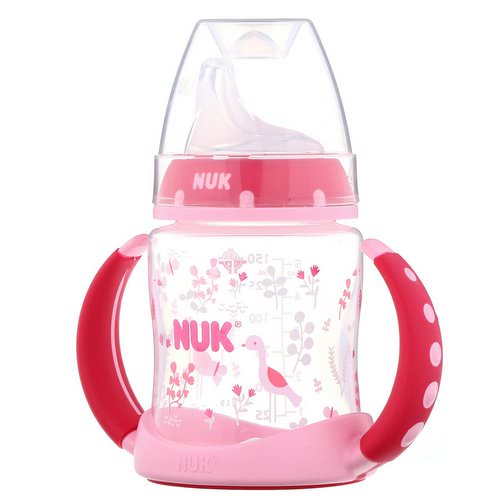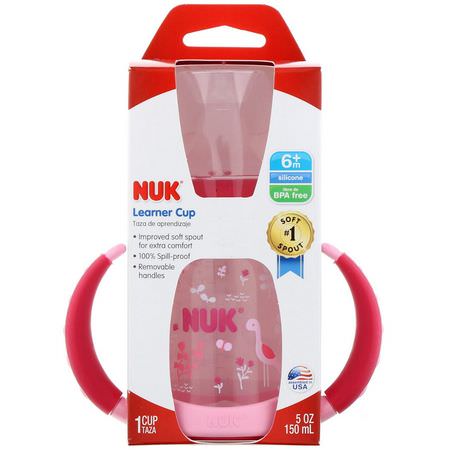Foodpharmacy Blog: Kids, Baby, Kids Feeding, Cups
NUK, Learner Cup, 6+ Months, Pink, 1 Cup, 5 oz (150 ml)

$5.20
Product name: NUK, Learner Cup, 6+ Months, Pink, 1 Cup, 5 oz (150 ml)
Quantity: 1 Count, 0.11 kg, 16.3 x 11.4 x 7.4 cm
Categories: NUK, Baby, Kids, Kids Feeding, Cups, Bpa Free
Improved Soft Spout for Extra Comfort, 100% Spill-Proof, Removable Handles, Siicone, BPA Free Satiny Finish for More Comfort, #1 Soft Spout, The transition from breast to bottle to cup is simple with easy-to-hold NUK Learner Cup, Cap – Keeps spout clean, Improved spill-proof soft spout – 100% silicone spout with a soft, satiny finish for extra comfort, Extra wide neck – For easier filling and cleaning, Removable, easy grip handles – Ergonomically designed for little hands, For 60 Years, moms have trusted NUK products to help them nurture their babies best.

And that includes using nontoxic utensils, plates, bowls, bottles and cups. Sippy cups vary in a whole lot of ways, you have sippy cups with straw, spill proof ones, eco-friendly ones and a lot more. Packed full of great kitchen essentials including bowls, plates, kitchen utensils, feeding sets, sippy cups, reusable snack bags, fruit bowls and training cups. There are also other options, such as the no-spill cups that bridge the gap between sippy, straw, and open cups. The ultimate test of any sippy cup, for me, is the smoothie: Can smoothie come through the opening such that my child can take a smoothie out of the kitchen and still be able to drink it? These are the cups used between bottle or breast feeding and regular cup use. Some pediatric experts recommend phasing out of sippy cups by 12 months. Pretty much all you really need, when letting your kid eat or drink on his own, which deserves the number one spot on our list. When you switch out the bottle for the cup, continue to snuggle with her like you normally would when feeding from the bottle.
NUK, Learner Cup, 6+ Months, Pink, 1 Cup, 5 oz (150 ml): Cups, Kids Feeding, Kids, Baby
Almost all of them do not have either of the handle and they have thin design and long body that provides good griping for child. They act as a link in the transition from breast/bottle feeding to drinking from a conventional open cup. Just a word of caution straw cups can be hard to clean if you use milk in them, so be sure to clean every nook and cranny. Transitioning from bottle to cup (For all liquids other than directly from the breast) will allow your baby to exercise her face muscles (Lips and jaw), tongue, and soft palate, all of which are connected to speech and feeding. When your child is at very early age he needs something soft and easy to hold. All good things rolled into one, with a design that would help your baby in slowly getting accustomed to drinking from a cup independently, because as your baby progresses, you could also remove the training handle and voila! With an intelligent design, this particular cup allows your baby to get enough fluid without gagging or needing to suck it too challenging. Infants below 7 months should use sippy cups with handles because their hands are too small to hold and lift the cups. If you are just introducing your baby to sippy cups, get the thinkbaby thinkster straw bottle. At this stage, a child will not be eating solids.

It’s spoutless rim design is great for older toddlers who have graduated to open cups, but who still need spill protection on the go. In a recent study by the pediatrics journal, they found that 9 months is the optimal age for switching a baby from a bottle (Whether formula or breast milk) to a sippy cup. Founder georgie started the business with a mission to make safer and more eco-friendly food and drink storage options for families. I have so many different brands of cups: Some with straws, some with just no spill lids, and some that kind of look like this. Once your kid gets the hang of these they can graduate to the model without handles. For babies, the cups catered to them are usually 5 to 6 ounces while the cups catered to toddlers are usually 9 to 12 ounces. On the other hand, some parents opt to buy the cups with wider mouths because they are easier to pour liquids in. We recommend going with the smallest for kids, as the larger sizes will probably be too heavy for them when filled with water.
While this stage is known as the hard spout stage, some companies will make stage two sippy cups with soft spouts, which may help if you would like to go straight from the bottle to a stage two cup. After using a bunch of different sippy cups on my own son and talking to a top pediatrician about what to look for, these are the best sippy cups i have found. Read our comprehensive best sippy cups buying guide here. Also, try to keep away from those cups that look extremely complex and hard to deal with. I sort of dread that time, just because sippy cups are notoriously so hard to wash. That said, we think these cups are pretty awesome, and know most kids will be happy with the colors. So as to manage and control the cups easy handles are provided on the either side of the cups. As the membrane is clear the baby can see how the liquid moves inside the cup which helps to train hand coordination.
However, because kids tend to walk around with sippy cups for an extended time, it’s generally best to mainly put water in the sippy cup to avoid the tooth decay that can come from the pooling of sugars present in milk (Naturally occurring, but still sugars), formula and especially juice or soda. The goal is to teach the child how to drink out of a proper cup, while still maintaining the spill-proofing of a sippy cup. If you are reading this, it means that your baby is now ready to move on to the next stage of development. In addition to learning the proper tongue and mouth placement for drinking (Rather than suckling), your baby must also master the hand-eye coordination required to hold, lift, and tip her cup towards her mouth, all while sitting upright on her own. The body of the durable cup is made from high-quality food-grade stainless steel material. The characteristic feature of these cups is the presence of two handles that help in easy gripping. If your child is able to, having them practice this important skill, even while having a sippy cup, is really valuable. Do sippy cups cause cavity or tooth decay? It may seem counterintuitive, but some studies suggest that kids who drink low-fat milk may actually have a higher risk of being overweight. The baby can drink from anywhere on the rim, which is why the cup is called 360-degrees cup.
NUK Cups
This is a great feature when your child is playing around other children and it is easy for cups to get mixed up. Eco vessel insulated sippy is made of food-grade stainless steel and has no lining of any kind. Therefore, do not hesitate in trying as many cups as you can to figure out the best one for your baby. It is available as a water bottle in attractive colours and design so that child enjoys drinking from it. 4 Connecticut children’s medical center, hartford, ct, usa. T here are millions of children that drink sippy cups and have no problems at all. Sippy cups are suitable for babies older than six months. Rimless cups look like standard cups meant for adults but actually have a closed mouth with the presence of small slits on the mouth-disc.
Of them, i use and enjoy the nuk learner sippy cups. For younger kids, start with the smallest size (3,13 Ounces) for easy grip. There are various cups to select from, one must select a trainer cup at initial ages and later must switch to 360 cup so that a child could learn to drink from normal mug soon. These rimless cups make it easy for babies to drink from a cup while preventing spills. If you choose to use a glass cup or bottle for your toddler or baby, we recommend you inspect it closely before every use. Hence, kids should not use them for too long. If you are sure that your baby is ready to take sippy cups at an early age of 4 to 12 months you can introduce trainer cups to your baby. And, while all sippy cups claim to be spill-proof, not all of them really do keep the liquids inside the cup. This is a simple, sanitary sippy cup option for those whose children do not like hard spouts.
The sleeve helps prevent breakage when your kiddo inevitably drops the jar. The variety you choose is up to you and your baby. Some of the stainless and glass cups are more expensive upfront, but they also tend to last for years. Your child not only needs to learn how to drink but also how to make sure that he or she is not spilled on or does not spill all over the floor or furniture. Sippy cups are as unique as the children who use them. Even with this minor flaw, however, this cup should still be looked at closely by parents looking for a cup for their 12-month or older child. The child can drink from any side, helping to develop the proper skills and muscles needed to transition to an open cup.
It is treated that at this age child need more intake of liquid and thus it holds up to 7 to 12 ounce and thus child remain hydrated for long. Simply put, every household would greatly benefit from having a few of the first years take and toss cups around. I know many parents that have success with learning cups, even early on. If your baby bottle-feeds thrice a day, then switch one bottle feeding session with sippy cup. But going through both these stages are not necessary for each child, as some have no issue going straight to a hard spout. The elk and friends kids cups are beautifully simple and can double as food storage. These are very simple cups at a good price for a package of three. These trainer cups hold up to 5 ounces of liquid.
The point is, that just like the literature on pacifier or thumb sucking via the ada and other professional journals, an object that holds the tongue down promotes the motor pattern that we want kids to grow out of. While many parents believe transitioning from bottle to sippy cup is a right of passage, your kid is actually better off with a sippy cup alternative, such as a straw or training cup! As the child advances, the handles can be removed to help teach your child how to hold their cup on their own before training with an open cup.